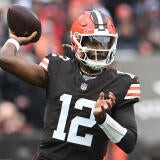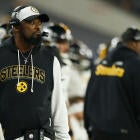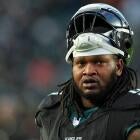Colts-Texans Thursday Night Football preview: Five stats to know
Pressuring Matt Hasselbeck and slowing down the Colts offense could be the key to a home win for the Texans on Thursday night. Here are the advance stats you need to know for the Week 5 showdown.

We aren't quite sure if the Indianapolis Colts are a good or bad team yet, but we could get a better idea when Matt Hasselbeck and Co. travel to Houston to face J.J. Watt and the Texans.
Bill O'Brien's team has been disastrous through the first quarter of the season, with an unenviable quarterback carousel as a main storyline.
Both teams came into the season with relatively high expectations but have fallen well short to start the year.
Here are the five advanced stats to know for the Colts-Texans Week 5 matchup on Thursday Night Football.
1. Quarterback makes a difference?
Conventional wisdom regarding who's responsible for quarterback sacks is shifting. More people realize now that it's not always simply on the offensive line when a signal-caller is taken to the turf. Pocket maneuverability and time to release undoubtedly factor in. And we all know there is a varying degree of those skills among all quarterbacks.
With all that in mind, take a look at how Indianapolis' much-maligned offensive line performed against the Jaguars in Week 4 with Hasselbeck under center compared to the first three games of 2015 when Andrew Luck took the snaps.
| Colts surrendering sacks (overall grades) | ||
| Player | vs. Jaguars | Avg. first 3 games |
| Anthony Castonzo | 3.9 | -1.133333333 |
| Jack Mewhort | 3.2 | -0.6 |
| Khaled Holmes | -0.8 | -1.233333333 |
| Hugh Thornton | 2.2 | -2.233333333 |
| Joe Reitz | 1.4 | 0.4333333333 |
| Source: Pro Football Focus | ||
On paper, the Bills, Jets and Titans pass-rushes are more potent than the Jaguars. So that may have contributed to the spike in offensive line performance for the Colts against Jacksonville. However, outside of playing different defenses, the other striking difference was Hasselbeck under center instead of Luck. How much did it matter?

2. Hasselbeck vs. Luck
Against the Jaguars, on average, Matt Hasselbeck released the football in 2.28 seconds. In Luck's three games, his average was 2.41.
In an attempt to decide how much each quarterback's tendency to hold onto the football impacts the pressure he sees, take a peek at the pressure numbers from Hasselbeck's Week 4 start against the Jaguars compared to Luck's numbers in September
| Pressuring Colts quarterbacks | |||
| Sacks | Hits | Hurries | |
| Luck's 2015 Averages | 2 | 7 | 14.7 |
| Hasselbeck vs. Jaguars | 5 | 4 | 6 |
| Jaguars' 2015 Averages | 3.25 | 3 | 10.25 |
| Texans' 2015 Averages | 1.75 | 2.5 | 9.5 |
| Source: Pro Football Focus | |||
There's no doubt Luck is more apt to hang in the pocket longer than Hasselbeck, and that likely leads to the former No. 1 overall pick dealing with more overall pressure.
While Hasselbeck's sack number was high, notice how many more times Luck was being hurried. Taking a sack, hit or hurry on 15 of 50 dropbacks is a respectable number.
Then again -- and this bodes well for Hasselbeck -- based on the numbers, the Texans' pass-rush has actually been less productive than the Jaguars, which comes as a major shock.
3. DeAndre Hopkins, target accumulator
It doesn't matter which quarterback the Texans send out there -- DeAndre Hopkins is going to be thrown the football. A lot.
Take a look at the pace on which Hopkins' 61 targets through four games puts him, and also note how bad his efficiency has been in largely due to incompetent signal-caller play.
| Hopkins vs. Other High-Target WRs | |||
| Targets | Catch % | Catchable % | |
| 2015 Hopkins (Pace) | 244 | 50.8 | 57.3 |
| 2002 Marvin Harrison | 202 | 69.3 | n/a |
| 2012 Calvin Johnson | 199 | 61.3 | 68.3 |
| 2014 Antonio Brown | 178 | 72.4 | 75.2 |
| Source: Pro Football Focus | |||
Among the 90 most-targeted receivers in 2014, only six of them had a catchable percentage lower than Hopkins' current rate of 57.3. That's on the quarterbacks.
How good is Hopkins though?
Well, despite getting passes thrown to him by the disappointing Brian Hoyer and Ryan Mallett this season, the third-year wideout currently averages 1.95 yards per route run, good for 30th in the NFL among 70 qualifying receivers.
4. Examining J.J. Watt
Those who say J.J. Watt could have won the Defensive Player of the Year award the past three seasons have a strong case.
He won last year and in 2012, and his "down" campaign of 2013 saw him register 65 tackles, knock down seven passes, force four fumbles and accumulate 10½ sacks.
But things haven't gone as swimmingly for Watt in 2015.
| Measuring J.J. Watt's impact | |||
| QB Pressures | Final Overall Grade | Grade pace through 4 games | |
| 2015 (Pace) | 64 | 86.0 | 86.0 |
| 2014 | 119 | 107.5 | 100.4 |
| 2013 | 85 | 99.8 | 99.2 |
| 2012 | 76 | 94.6 | 106.8 |
| Source: Pro Football Focus | |||
Watt's overall PFF grades of 94.6 or higher starting in 2012 were astronomical, as the second-place finisher at the 3-4 defensive end position each year finished with a grade in the 30s.
Three straight tremendous seasons have gotten Watt an abundance of deserved attention as the NFL's defensive ambassador during the league's offensive renaissance.
The perennial All-Pro has mentioned to the media that he's seeing more attention from offensive lines than ever before ... and rightfully so.
Per Rick Stroud of the Tampa Bay Times, Watt said, "I think so far this year, there's already been more triple teams than the past."
Yeah, triple teams.
In 2014, Watt had two plus-8.2 grades in games against the Colts, which featured a combined 18 quarterback pressures.
Indianapolis must do everything it can to double, and maybe even triple-team Watt in this vital AFC South game.

5. Tempo matters, or does it?
If you had to venture a guess as to what team has had the quickest offensive tempo through four games, you would probably figure it's either the Philadelphia Eagles or New England Patriots.
Nope.
It's the Houston Texans.
Clearly some of Bill Belichick's ideologies have rubbed off on Bill O'Brien. However, it hasn't necessarily led to effectiveness on that side of the ball for Houston.
Furthermore, the Colts have faced a quartet of relatively "slow" paced attacks.
| Setting the tempo | |||
| Seconds per play (Rank) | Yards per play (Rank) | ||
| Texans Offense | 20.96 (1) | 4.9 (30) | |
| Colts Defense | 28.49 (21) | 5.7 (22) | |
| Sources: Football Outsiders, TeamRankings.com | |||
For perspective on the Texans' offensive speed, the Eagles led the league in 2014 at 21.95 seconds per play and were tops in football in 2013 with 23.38 seconds per play.
Obviously, it's harder to sustain the fast tempo for an entire season, but, for some reason, the Texans have made going up-tempo one of the foundations of their offensive philosophy.
Maybe if they get more methodical with the ball in their possession they'll improve their yards-per-play average and boost their overall efficiency.
It wouldn't be a bad idea for Houston to start doing just that against the Colts defense, a unit that has had its issues with teams that like to go slower on offense.
Prediction: The Colts will have their fair share of mistakes in this one, and most of them will come due to the offensive line and Hasselbeck's inability to stretch the field. But I think the Texans will make more mistakes, even against a susceptible Indianapolis defense. It's extremely difficult to trust Ryan Mallett at this point. On the road, Chuck Pagano's team will move to 3-2 on the year after a rough start. Colts 24, Texans 13
















